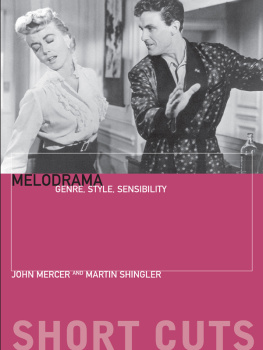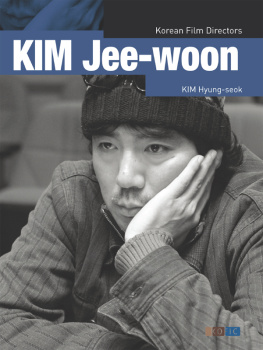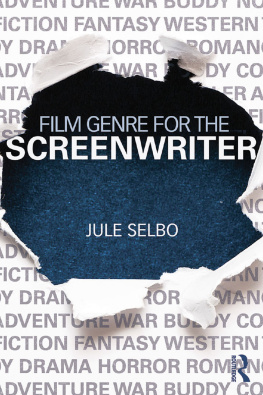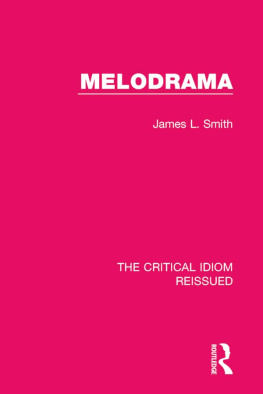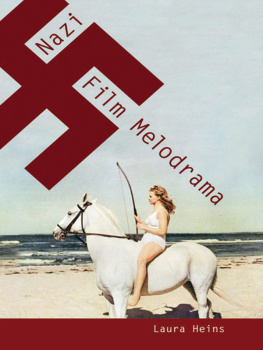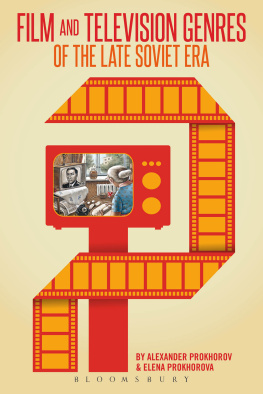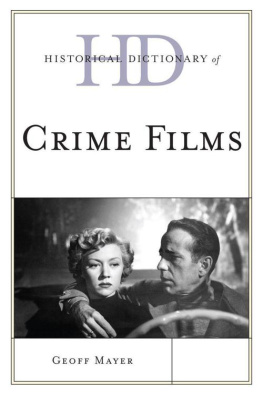SHORT CUTS
INTRODUCTIONS TO FILM STUDIES
OTHER TITLES IN THE SHORT CUTS SERIES
THE HORROR GENRE: FROM BEELZEBUB TO BLAIR WITCH Paul Wells
THE STAR SYSTEM: HOLLYWOODS PRODUCTION OF POPULAR IDENTITIES Paul McDonald
SCIENCE FICTION CINEMA: FROM OUTERSPACE TO CYBERSPACE Geoff King and Tanya Krzywinska
EARLY SOVIET CINEMA: INNOVATION, IDEOLOGY AND PROPAGANDA David Gillespie
READING HOLLYWOOD: SPACES AND MEANINGS IN AMERICAN FILM Deborah Thomas
DISASTER MOVIES: THE CINEMA OF CATASTROPHE Stephen Keane
THE WESTERN GENRE: FROM LORDSBURG TO BIG WHISKEY John Saunders
PSYCHOANALYSIS AND CINEMA: THE PLAY OF SHADOWS Vicky Lebeau
COSTUME AND CINEMA: DRESS CODES IN POPULAR FILM Sarah Street
MISE-EN-SCNE: FILM STYLE AND INTERPRETATION John Gibbs
NEW CHINESE CINEMA: CHALLENGING REPRESENTATIONS Sheila Cornelius with Ian Haydn Smith
SCENARIO: THE CRAFT OF SCREENWRITING Tudor Gates
ANIMATION: GENRE AND AUTHORSHIP Paul Wells
WOMENS CINEMA: THE CONTESTED SCREEN Alison Butler
BRITISH SOCIAL REALISM: FROM DOCUMENTARY TO BRIT GRIT Samantha Lay
FILM EDITING: THE ART OF THE EXPRESSIVE Valerie Orpen
AVANT-GARDE FILM: FORMS, THEMES AND PASSIONS Michael OPray
PRODUCTION DESIGN: ARCHITECTS OF THE SCREEN Jane Barnwell
NEW GERMAN CINEMA: IMAGES OF A GENERATION Julia Knight
EARLY CINEMA: FROM FACTORY GATE TO DREAM FACTORY Simon Popple and Joe Kember
MUSIC IN FILM: SOUNDTRACKS AND SYNERGY Pauline Reay
FEMINIST FILM STUDIES: WRITING THE WOMAN INTO CINEMA Janet McCabe
MELODRAMA
GENRE, STYLE, SENSIBILITY
JOHN MERCER and MARTIN SHINGLER

WALLFLOWER
LONDON and NEW YORK
A Wallflower Book
Published by
Columbia University Press
Publishers Since 1893
New York Chichester, West Sussex
cup.columbia.edu
Copyright John Mercer and Martin Shingler 2004
All rights reserved.
E-ISBN 978-0-231-50306-8
A complete CIP record is available from the Library of Congress
ISBN 978-1-904764-02-1 (pbk. : alk. paper)
ISBN 978-0-231-50306-8 (e-book)
A Columbia University Press E-book.
CUP would be pleased to hear about your reading experience with this e-book at .
CONTENTS
Martin Shingler
This is a book I have been itching to write ever since I completed my undergraduate dissertation on the Hollywood family melodrama, so my first debt of gratitude is to my original film tutors, in particular Roger Powell and Peter Packer. It was this initial, tentative exploration of melodrama that led me to Thomas Elsaesser, with whom I studied for my Masters degree. His dedication to the study of film encouraged me to begin my PhD, and I continue to draw inspiration from his work and confidence from his support. My third debt is to the late Irving Rapper who, a few years before his death at the age of 101, generously talked to me over the telephone, from his bed in a New York apartment, about his life and work. I learnt then how much sensitivity and sheer humanity lay behind Now, Voyager, the film that had fired my imagination and initiated my earliest investigations into Hollywood melodrama. I am also indebted to all my colleagues in the Media Studies department at Staffordshire University for covering my teaching commitments during intensive periods of writing. I am particularly grateful to my good friend Ulrike Sieglohr, for the time and effort taken to read through drafts of my chapters and for all her sensible and practical suggestions for improvements. Likewise, Christine Gledhill, whose critical work has enabled me to formulate many of the ideas set down here, has also provided invaluable help, clarifying issues and concerns. The inspiration of her writing, her teaching, her enthusiasm for research and new ways of thinking, her energy and vision, not forgetting her friendship all these have been vital, stimulating and rewarding. To Simon I owe the space to work in peace, for the treats and rewards in between, for listening to all my ideas when only half-baked and setting me back on course when straying into uncertain territory or simply failing to make sense. My final debt is to my co-writer John, for inviting me to be part of this project, for constant encouragement without pressure, for taking up the reins and getting the whole enterprise organised and ensuring we made good use of our time, for taking my many and varied concerns on board without hesitation or objection and, most of all, for being such good fun to work with.
To my father who always cries at The Sound of Music and my mother who saves her tears for real life.
John Mercer
I would like to thank my colleagues in the Arts and Media department at BCUC for their encouragement and ceaseless energy. I would particularly like to thank Ruth Gunstone, Alison Tedman and Lois Drawmer for their friendship and good humour that make my work such a pleasure. I would also like to thank my students whose own efforts to grapple with the difficult ideas discussed here and often stimulating observations and insights have helped shape the structure of this study. Like Martin, I would also like to extend my gratitude to Christine Gledhill who has been an instrumental figure both in the shaping of many of the ideas that this book deals with, and at a more personal level, for giving me my first opportunities to pursue a career as a film scholar. Thanks also to Martin, whose friendship, enthusiasm and expertise has made the completion of this study possible. Finally thanks to Trevor for his years of love, support and endless patience.
I dedicate this book to the memory of my grandparents, Bob and Mabel Nicholson, whose enthusiasm for cinema inspired my own fascinations at an early age. I love and miss you both.
When, in 1971, retired Hollywood director Douglas Sirk gave an interview to Jon Halliday at his home in Switzerland, he could hardly have imagined the effect that his comments concerning the films that he made during his years as a contract director at Universal were to have on a succession of young filmmakers and on the emerging discipline of films studies. Sirks identification of several of his films as melodramas in effect initiated a debate around Hollywood cinema of the 1950s and its representation of the trials and tribulations of family life that has evolved into the identification of a broad category of cinema, one that often deals with highly-charged emotional issues, characterised by an extravagantly dramatic register and frequently by an overtly emotional mode of address.
Melodrama, however one might understand the term, always has the ability to provoke strong emotions in audiences, from tears of sorrow and identification, to derisive laughter. These powerful and contradictory responses are duplicated, to a greater or lesser degree, in the debates that have circulated amongst film scholars about what constitutes melodrama in cinema, its function as a genre, a filmic style or an expressive code. The melodrama debate that commences at the start of the 1970s includes some of the most complicated and difficult ideas in Film Studies and engages with almost all of the key theoretical ideas within the discipline, from questions of genre and authorship, to issues surrounding representation, aesthetics and the ideological function of cinema.
The challenge of this book, then, is to organise a range of, often conflicting, critical responses to the subject of melodrama into a coherent structure as an introduction to this complex area of film theory. Readers should be aware that this book offers no single definition of what melodrama is. Rather it should be understood as offering an overview of the various ways in which film theorists have made use of melodrama as a term and its associated debates to discuss key issues such as authorship, genre, ideology, cinematic

